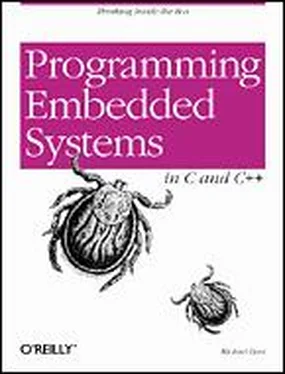Watchdog Timers
Another type of timer you might hear mentioned frequently in reference to embedded systems is a watchdog timer. This is a special piece of hardware that protects the system from software hangs. If present, the watchdog timer is always counting down from some large number to zero. This process typically takes a few seconds to complete. In the meantime, it is possible for the embedded software to "kick" the watchdog timer, to reset its counter to the original large number. If the counter ever does reach zero, the watchdog timer will assume that the software is hung. It then resets the embedded processor and, thus, restarts the software.
This is a common way to recover from unexpected software hangs that occur after the system is deployed. For example, suppose that your company's new product will travel into space. No matter how much testing you do before deployment, the possibility remains that there are undiscovered bugs lurking in the software and that one or more of these is capable of hanging the system altogether. If the software hangs, you won't be able to communicate with it at all, so you can't just issue a reset command remotely. Instead, you must build an automatic recovery mechanism into the system. And that's where the watchdog timer comes in.
The implementation of the watchdog timer "kick" would look just like the Blinking LED program in this chapter, except that instead of toggling the LED the watchdog timer's counter would be reset.
Another potential feature of the Timer class is asynchronous callbacks. In other words, why not allow the creator of a software timer to attach a function to it. This function could then be called automatically — via timerList.tick — each time that timer expires. As you read the next section, be sure to think about how different the Blinking LED program would look if asynchronous callbacks were used instead. This is one type of application to which asynchronous function calls are particularly well suited.
7.4 Das Blinkenlights, Revisited
Now that we have the Timer class at our disposal, it is possible to rewrite the book's very first example to make its timing more precise. Recall that in our original implementation, we relied on the fact that the length of a "decrement and compare" operation was fixed for a given processor and speed. We simply took a guess as to how long that might be and then revised our estimate based on empirical testing. By utilizing the Timer class, we can simultaneously eliminate this guesswork and increase the readability of the program.
In the revised Blinking LED program below you will see that we can now simply start a periodic 500 ms software timer, toggle the LED, and then wait for the timer to expire before toggling the LED again. In the meantime, we could perform other processing tasks required by the application at hand.
#include "timer.h"
#include "led.h"
/**********************************************************************
*
* Function: main()
*
* Description: Blink the green LED once a second.
*
* Notes: This outer loop is hardware-independent. However, it
* calls the hardware-dependent function toggleLed().
*
* Returns: This routine contains an infinite loop.
*
**********************************************************************/
void main(void) {
Timer timer;
timer.start(500, Periodic); // Start a periodic 500 ms timer.
while (1) {
toggleLed(LED_GREEN); // Toggle the green LED.
// Do other useful work here.
timer.waitfor(); // Wait for the timer to expire.
}
} /* main() */
Chapter 8. Operating Systems
osophobian. A common fear among embedded systems programmers.
ALL but the most trivial of embedded programs will benefit from the inclusion of an operating system. This can range from a small kernel written by you to a full-featured commercial operating system. Either way, you'll need to know what features are the most important and how their implementation will affect the rest of your software. At the very least, you need to understand what an embedded operating system looks like on the outside. But there's probably no better way to understand the exterior interfaces than to examine a small operating system in its entirety. So that's what we'll do in this chapter.
In the early days of computing there was no such thing as an operating system. Application programmers were completely responsible for controlling and monitoring the state of the processor and other hardware. In fact, the purpose of the first operating systems was to provide a virtual hardware platform that made application programs easier to write. To accomplish this goal, operating system developers needed only provide a loose collection of routines — much like a modern software library — for resetting the hardware to a known state, reading the state of the inputs, and changing the state of the outputs.
Modern operating systems add to this the ability to execute multiple software tasks simultaneously on a single processor. Each such task is a piece of the software that can be separated from and run independently of the rest. A set of embedded software requirements can usually be decomposed into a small number of such independent pieces. For example, the printer-sharing device described in Chapter 5, contains three obvious software tasks:
• Task 1: Receive data from the computer attached to serial port A.
• Task 2: Receive data from the computer attached to serial port B.
• Task 3: Format and send the waiting data (if any) to the printer attached to the parallel port.
Tasks provide a key software abstraction that makes the design and implementation of embedded software easier and the resulting source code simpler to understand and maintain. By breaking the larger program up into smaller pieces, the programmer can more easily concentrate her energy and talents on the unique features of the system under development.
Strictly speaking, an operating system is not a required component of any computer system-embedded or otherwise. It is always possible to perform the same functions from within the application program itself. Indeed, all of the examples so far in this book have done just that. There is simply one path of execution-starting at main — that is downloaded into the system and run. This is the equivalent of having only one task. But as the complexity of the application expands beyond just blinking an LED, the benefits of an operating system far outweigh the associated costs.
If you have never worked on operating system internals before, you might have the impression that they are complex. I'm sure the operating system vendors would like you to continue to believe that they are and that only a handful of computer scientists are capable of writing one. But I'm here to let the cat out of the bag: it's not all that hard! In fact, embedded operating systems are even easier to write than their desktop cousins — the required functionality is smaller and better defined. Once you learn what that functionality is and a few implementation techniques, you will see that an operating system is no harder to develop than any other piece of embedded software.
Embedded operating systems are small because they lack many of the things you would expect to find on your desktop computer. For example, embedded systems rarely have disk drives or graphical displays, and hence they need no filesystem or graphical user interface in their operating systems. In addition, there is only one "user" (i.e., all of the tasks that comprise the embedded software cooperate), so the security features of multiuser operating systems do not apply. All of these are features that could be part of an embedded operating system but are unnecessary in the majority of cases.
Читать дальше












